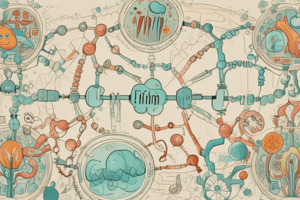Podcast
Questions and Answers
What is the primary role of glycine in collagen synthesis?
What is the primary role of glycine in collagen synthesis?
- It is present in every third position of the collagen helix. (correct)
- It functions as an energy source.
- It stabilizes the collagen structure.
- It acts as a hormone in collagen formation.
Which amino acid acts as an inhibitory neurotransmitter in the spinal cord?
Which amino acid acts as an inhibitory neurotransmitter in the spinal cord?
- Phenylalanine
- Glutamate
- Tyrosine
- Glycine (correct)
Which amino acid is essential and plays a role in the formation of tyrosine?
Which amino acid is essential and plays a role in the formation of tyrosine?
- Glycine
- Phenylalanine (correct)
- Methionine
- Glutamate
What is the fate of glycine in heme synthesis?
What is the fate of glycine in heme synthesis?
Which of the following statements about phenylalanine is true?
Which of the following statements about phenylalanine is true?
What compound is formed when glycine conjugates with benzoate?
What compound is formed when glycine conjugates with benzoate?
Which enzyme is responsible for converting phenylalanine to tyrosine?
Which enzyme is responsible for converting phenylalanine to tyrosine?
What type of amino acid is glycine classified as?
What type of amino acid is glycine classified as?
What is the precursor of thyroid hormones T3 and T4?
What is the precursor of thyroid hormones T3 and T4?
Which amino acid is involved in the synthesis of serotonin?
Which amino acid is involved in the synthesis of serotonin?
Which of the following is NOT a biosynthetic derivative of tryptophan?
Which of the following is NOT a biosynthetic derivative of tryptophan?
What is the classification of arginine?
What is the classification of arginine?
Which process involves serine in the synthesis of other compounds?
Which process involves serine in the synthesis of other compounds?
Which of the following statements about methionine is true?
Which of the following statements about methionine is true?
Glutamic acid is primarily synthesized from which compound?
Glutamic acid is primarily synthesized from which compound?
What is one of the functions of serine?
What is one of the functions of serine?
Flashcards
What is Glycine?
What is Glycine?
Glycine is a non-essential amino acid that plays a crucial role in various metabolic processes, including purine synthesis, glutathione formation, and heme synthesis.
Glycine's Role in Purine Synthesis
Glycine's Role in Purine Synthesis
Glycine provides carbon atoms 4 and 5, along with nitrogen atom 7, for the synthesis of purine bases, essential components of DNA and RNA.
Glycine's Role in Glutathione
Glycine's Role in Glutathione
Glycine is a component of glutathione, a tripeptide that acts as a crucial antioxidant and plays a vital role in detoxification.
Glycine's Role in Heme Synthesis
Glycine's Role in Heme Synthesis
Signup and view all the flashcards
Glycine's Role in Collagen Synthesis
Glycine's Role in Collagen Synthesis
Signup and view all the flashcards
Glycine's Role in Bile Salt Formation
Glycine's Role in Bile Salt Formation
Signup and view all the flashcards
Glycine's Role as a Neurotransmitter
Glycine's Role as a Neurotransmitter
Signup and view all the flashcards
What is Phenylalanine?
What is Phenylalanine?
Signup and view all the flashcards
What is the precursor amino acid of thyroid hormones T3 and T4?
What is the precursor amino acid of thyroid hormones T3 and T4?
Signup and view all the flashcards
What are pigments responsible for color in tissues like the eye, hair, and skin?
What are pigments responsible for color in tissues like the eye, hair, and skin?
Signup and view all the flashcards
What is tryptophan?
What is tryptophan?
Signup and view all the flashcards
What neurotransmitter is synthesized from tryptophan?
What neurotransmitter is synthesized from tryptophan?
Signup and view all the flashcards
What is the precursor amino acid for arginine synthesis in microorganisms?
What is the precursor amino acid for arginine synthesis in microorganisms?
Signup and view all the flashcards
What is one of the key roles of arginine in the body?
What is one of the key roles of arginine in the body?
Signup and view all the flashcards
What is glutamic acid synthesized from?
What is glutamic acid synthesized from?
Signup and view all the flashcards
What amino acid is glutamine synthesized from?
What amino acid is glutamine synthesized from?
Signup and view all the flashcards
Study Notes
Amino Acid Metabolism
- Glycine is a non-essential, glucogenic amino acid.
- Glycine's fate includes the formation of purine bases (carbon atoms 4, 5, and nitrogen atom 7 are derived from glycine) and glutathione (a tripeptide of glutamate, cysteine, and glycine; acts as a hydrogen carrier).
- Creatine (methyl-guanido-acetate) is used by muscles as creatine phosphate, a source of energy during exercise. It's synthesized from glycine, arginine, and methionine.
- Glycine reacts with succinyl CoA to form heme during heme synthesis.
- Collagens have a triple helical structure with glycine present in every third position (Gly-X-Y-Gly-X-Y-Gly-X-Y...).
- Glycine conjugates with primary bile acids (e.g., cholic acid) to form glycocholic acid (bile salts).
- Glycine conjugates with toxic benzoate to form the non-toxic hippuric acid.
- Glycine acts as an inhibitory neurotransmitter in the spinal cord.
- Glycine participates in the formation of glyoxylic acid.
Phenylalanine
- Phenylalanine is an essential, mixed glucogenic/ketogenic amino acid.
- It is involved in the structure of body proteins and the formation of tyrosine primarily in the liver.
- The conversion of phenylalanine to tyrosine is an irreversible reaction catalyzed by phenylalanine hydroxylase.
- Deficiency in any component of this pathway can lead to phenylketonuria.
- Dihydrobiopterin reductase and tetrahydrobiopterin are enzymes involved in the process, along with oxygen.
Tyrosine
- Tyrosine is a non-essential amino acid derived from phenylalanine.
- It is a mixed glucogenic/ketogenic amino acid.
- Important derivatives of tyrosine include catecholamines (dopamine, noradrenaline, adrenaline) in the adrenal medulla and adrenal neurons.
- It's also a precursor for thyroid hormones (T3 and T4) in the thyroid gland.
- Tyrosine is involved in the synthesis of melanin pigments and the putrefactive substances phenol, cresol, and tyramine in the intestines.
Tryptophan
- Tryptophan is an essential, mixed glucogenic/ketogenic amino acid.
- Catabolism of tryptophan produces alanine and acetoacetyl CoA.
- It contributes to niacin (a B vitamin complex) synthesis.
- Tryptophan is a precursor in the synthesis of serotonin (5-hydroxytryptamine), a neurotransmitter.
- It is involved in melatonin synthesis, a hormone produced by the pineal gland.
- Tryptophan is used to synthesize indol and skatol.
Arginine
- Arginine is a semi-essential, glucogenic amino acid.
- Microorganisms can synthesize arginine from glutamate.
- Arginine participates in the synthesis of α-ketoglutarate.
- Arginine plays a role in creatine synthesis.
- It's involved in the synthesis of streptomycin, a component of some antibiotics.
- Arginine is used in the synthesis of urea and nitric acid as well as arginine phosphate in invertebrates.
Serine
- Serine is a non-essential, glucogenic amino acid involved in the synthesis of glycine, cysteine, ethanolamine, and choline.
- It's crucial for sphingosine formation (from serine and palmitoyl-CoA).
- Serine is a precursor to the methyl groups of pyrimidine bases (thymine) and purine bases (C2 and C8).
- It's also involved in the synthesis of phosphoproteins, such as casein.
Methionine
- Methionine is an essential, glucogenic amino acid.
- Its function is as a methyl donor (S-adenosyl methionine, SAM).
- SAM is important for the synthesis of creatine, adrenaline, noradrenaline, choline, and other compounds.
Glutamic Acid
- Glutamic acid is a non-essential, glucogenic amino acid.
- It's synthesized from α-ketoglutarate.
- It's involved in the synthesis of α-ketoglutarate, providing a glucose precursor.
- Glutamic acid is involved in glutamine, proline, hydroxyproline, ornithine, glutathione, and GABA (γ-aminobutyric acid) synthesis.
- GABA is an inhibitory neurotransmitter.
Aspartic Acid
- Aspartic acid is a non-essential, glucogenic amino acid.
- It's synthesized from oxaloacetate via transamination.
- Aspartic acid is essential for synthesizing purines (N1 group) and pyrimidines (N1, C4, C5, C6).
- It is a precursor to urea synthesis.
- It's involved in the synthesis of β-alanine and asparagine.
Studying That Suits You
Use AI to generate personalized quizzes and flashcards to suit your learning preferences.




